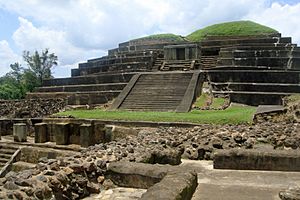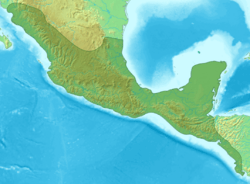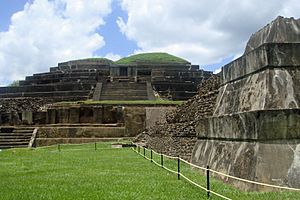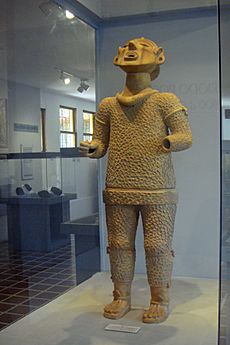Tazumal facts for kids

The Maya ruins of Tazumal
|
|
| Location | Santa Ana Department, El Salvador |
|---|---|
| Coordinates | 13°58′46″N 89°40′27″W / 13.97944°N 89.67417°W |
| History | |
| Periods | Preclassic to Late Postclassic |
| Cultures | Maya civilization |
Tazumal is an amazing ancient Maya site in Chalchuapa, El Salvador. It's a big group of old buildings within the larger ancient city of Chalchuapa. This special place is in the western part of El Salvador. An archaeologist named Stanley Boggs worked to dig up and fix parts of Tazumal in the 1940s and 1950s.
Scientists have found that people lived at Tazumal for a very long time, from the Classic period all the way to the Postclassic period. This means it was an active place for hundreds of years! Tazumal also had connections with faraway places like central Mexico and even other parts of Central America. Some of the oldest metal objects ever found in Mesoamerica, dating back to the 700s AD, came from Tazumal.
Contents
Where is Tazumal Located?
Tazumal is in a town called Chalchuapa, in the Santa Ana area of El Salvador. It sits near the Río Paz river basin. The ruins are about 720 meters (2,360 feet) above sea level. It is also about 120 kilometers (75 miles) from another old Maya city called Kaminaljuyu.
What is the History of Tazumal?
People lived in the Chalchuapa area, where Tazumal is, even before the Classic period. They built many large structures back then. But around the end of the Preclassic period, a huge volcano called Ilopango erupted. This volcano was about 75 kilometers (47 miles) east of the city.
How Did the Volcano Affect Tazumal?
The eruption stopped all building work at Tazumal for many years, maybe even for several generations. When people started building again, during the Early to Middle Classic period (around AD 250-650), the city never became as big as it was before the volcano. However, the Tazumal complex itself grew to be very impressive.
When Was Tazumal Most Important?
The main buildings at Tazumal were built during the Classic period (around AD 250-900). By the Late Classic period (around AD 600-900), Tazumal was a very important place for ceremonies. During the Early and Middle Classic periods (around AD 400-600), Tazumal had strong connections with the Maya city of Kaminaljuyu in Guatemala.
Who Else Influenced Tazumal?
Kaminaljuyu helped spread the influence of the powerful central Mexican city of Teotihuacán to the Pacific coast of Guatemala and El Salvador. Later, during the Late Classic, Tazumal also had links with Copán in Honduras. We know this from the buildings, sculptures, and pottery found at Tazumal. Pottery found at the site shows that people lived there continuously until about AD 1200.
Who Lived at Tazumal?
The people of Tazumal lived alongside the Nahua-speaking Pipils from the Classic period until at least AD 1200. It seems the Pipil influence came more from trade with neighboring Pipil groups than from them living directly at Tazumal.
When Was Tazumal Left Behind?
After AD 1200, most people left Tazumal. They moved west towards what is now the modern town of Chalchuapa. Chalchuapa was still lived in when the Spanish arrived. At that time, the people there were Poqomam Maya. The Poqomam are thought to have settled in Chalchuapa later, after the Pipil influence ended around AD 1200.
How Was Tazumal Restored?
Between 1942 and 1944, Stanley Boggs dug up and restored two main structures, B1-1 and B1-2. He even used modern cement to cover the buildings, thinking it looked like the original materials. Boggs' full report was not widely shared, and no more big digs happened until the early 2000s. In 1947, Tazumal was made a National Historic Monument.
Recent Discoveries and Repairs
In 2004, a side of Structure B1-2 fell down. This was likely due to tree roots and water damage. The cement used in the 1950s had trapped water inside the building, making it weaker. After this, two new archaeological projects started. One was by CONCULTURA (El Salvador's National Council for Culture and Art) to fix Structure B1-2. The other was by the Japanese University of Nagoya.
What Does Tazumal Look Like?
All the buildings at Tazumal face west. Scientists believe Tazumal has a Mesoamerican ballcourt, which is a special field for playing ancient games. This idea comes from two unexcavated mounds in a nearby cemetery. One of these mounds is quite damaged. Green obsidian tools found at Tazumal show that the site had connections with central Mexico.
Structure B1-1: The Main Pyramid
Structure B1-1 is the biggest building at Tazumal. It's a pyramid that was built and changed many times over the Classic and Early Postclassic periods. This pyramid sits on a large base called the Great Platform. This platform is about 73 by 87 meters (240 by 285 feet).
What Was Found in the Great Platform?
Archaeologists found a platform on the west side of the pyramid, about 30 meters (98 feet) long. Another similar platform was on the north side. These platforms were built separately at first, then joined to the Great Platform. It's thought there were also platforms on the east and south sides. In the area of the southern platform, an offering was found. It included a ceramic pot with jade pieces, shells, animal bones, and mica. The pot was decorated with images of people wearing headdresses.
How Did the Pyramid Grow?
Structure B1-1 likely started as a central temple with platforms on each side. As the site grew, the spaces between these platforms were filled in to create the Great Platform. The main pyramid was then built on this platform. The Great Platform itself was changed at least three times before it reached its final size.
Temple of the Columns
On the western platform of Structure B1-1, there's a building called the Temple of the Columns. Because all buildings at Tazumal face west, this temple might have been the main entrance or front of the pyramid. This building had square columns and two rooms.
Structure B1-2: The Stepped Pyramid
Structure B1-2 was built during the Late Classic period. It is southwest of the main pyramid B1-1. This pyramid also faces west and has three stepped levels on a low base. It was built in a style called talud-tablero, which means it has sloped walls (talud) and vertical panels (tablero). The pyramid is about 25 by 25 meters (82 by 82 feet) and stands about 6.8 meters (22 feet) tall.
Why Did B1-2 Collapse?
In October 2004, the south side of this pyramid collapsed. This happened because tree roots grew into the building and water got trapped inside due to the cement restoration from the 1950s. The roots went as high as 6 meters (20 feet) into the building, causing big cracks.
How Was B1-2 Built Over Time?
Structure B1-2 was built in four main stages. The first stage was about 4.7 meters (15 feet) tall. The second stage covered the first one and was built in three smaller steps. The third stage made the pyramid even taller, from four levels to five. The final stage was badly damaged when the structure collapsed in 2004.
Other Buildings at Tazumal
- Structure B1-3 and Structure B1-4 are the two buildings that make up the ballcourt. Digs in the early 2000s found the floor of an I-shaped ballcourt.
- Structure B1-8 is a round platform from the Late Classic period.
What Sculptures Were Found at Tazumal?
Sculptures have been found at Tazumal that date back to the Preclassic period. Two sculptures of a type called chacmool were found. These are figures of a person lying on their back with a bowl on their stomach. Also found were a jaguar sculpture and a human-like sculpture of the central Mexican god Xipe Totec. These sculptures look similar to art from central Mexico and the northern Yucatán Peninsula. One of the chacmool sculptures is in a museum in San Salvador.
What Metal Objects Were Found?
Three gold ornaments were found at Tazumal. They were made using a method called lost wax casting and are thought to be from the 700s AD. Finding these gold items shows that Tazumal had connections with people in lower Central America. These, along with some metal items from Copán, are among the earliest metal objects found in all of Mesoamerica. These items were found in a tomb from the Late Classic period.
What About Burials at Tazumal?
Workers who dug in the area of the eastern platform of B1-1 said they found many burials there. However, Stanley Boggs did not mention these in his reports.
Burial 1
Burial 1 was found under a ledge of Pyramid B1-2. It included a lower jaw and other bone pieces, along with pottery and obsidian tools. The bones were scattered, suggesting it was a secondary burial. This means the body was moved after death. It might have been a human sacrifice to dedicate the final stage of the pyramid. The teeth show it was a young adult. The pottery dates this burial to the Terminal Classic or Early Postclassic period.
Burial 2
Burial 2 was found under the western side of Structure B1-2. It's thought to be from the same time as Burial 1. This burial had many bone fragments, including parts of a skull, jaw, and ribs. The teeth show it was a child. Pottery pieces and ashes were also found with the bones. The ashes were tested and dated to the Late Classic to Early Postclassic period, between AD 770 and 1000.
See also
 In Spanish: Tazumal para niños
In Spanish: Tazumal para niños





